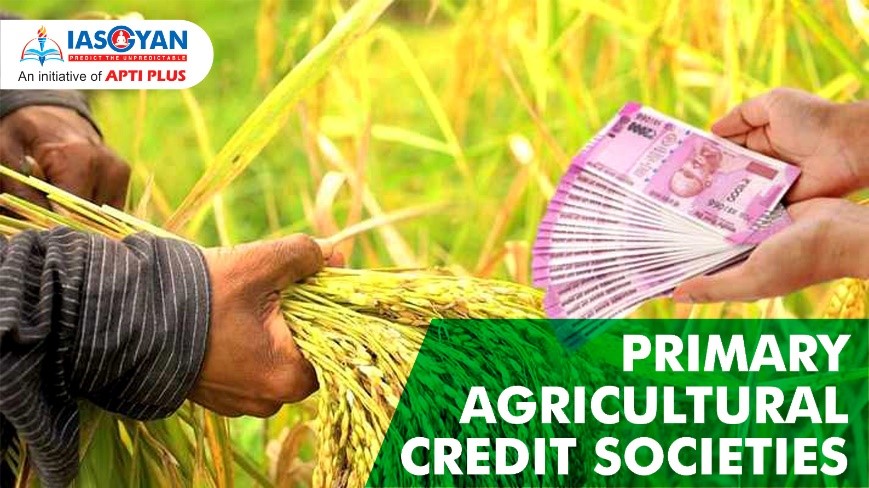
Disclaimer: Copyright infringement not intended.
Context:
- The Union Budget has announced Rs 2,516 crore for computerisation of 63,000 Primary Agricultural Credit Societies (PACS) over the next five years.
- Aim: To bring greater transparency and accountability in their operations and enabling them to diversify their business and undertake more activities.
What are Primary Agricultural Credit Societies?
- PACS are the ground-level cooperative credit institutions that provide short-term, and medium-term agricultural loans to the farmersfor the various agricultural and farming activities. It works at the grassroots gram Panchayat and village level.
- The first Primary agricultural Credit Society (PACS)was formed in the year 1904. Since then, these societies have been playing a significant role in providing short-term and medium-term credit to the farmers. Till the early seventies, this was the only institutional credit agency available to people in rural areas. The PACS functioning at the base of the cooperative banking system constitutes the major retail outlets of short-term and medium-term credit to the rural sector.
Working:
- PACS are village-level cooperative credit societies that serve as the last link in a three-tier cooperative credit structure headed by the State Cooperative Banks (SCB) at the state level.
- Credit from the SCBs is transferred to the district central cooperative banks, or DCCBs, that operate at the district level. The DCCBs work with PACS, which deals directly with farmers.
- Since these are cooperative bodies, individual farmers are members of the PACS, and office-bearers are elected from within them. A village can have multiple PACS
- PACS are involved in short-term lending — or what is known as crop loans. At the start of the cropping cycle, farmers avail credit to finance their requirement of seeds, fertilizers, etc.
- Banks extend this credit at 7 percent interest, of which 3 percent is subsidized by the Centre, and 2 percent by the state government. Effectively, farmers avail the crop loans at 2 percent interest only.
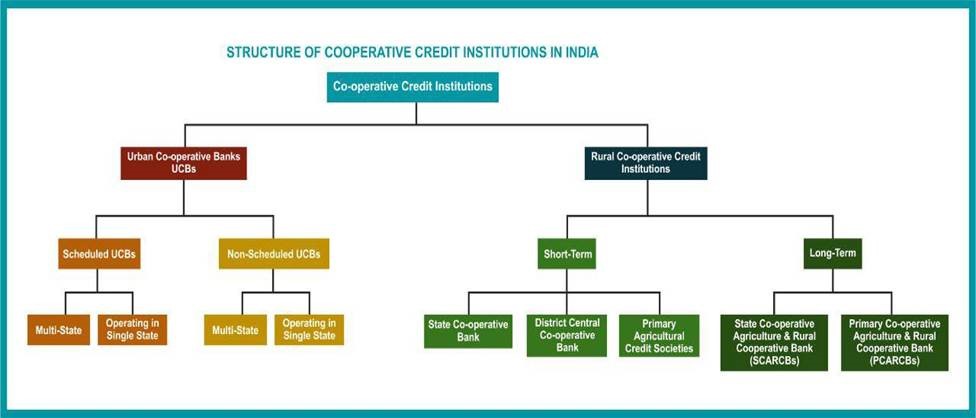
Features:
- The Primary Agricultural Credit Societies are the association of persons, unlike in the case of the Joint Stock Companies, where there is just accumulation of capital.
- Primary Agricultural Credit Societies confers equal rights to all its memberswithout considering their holding of share and their social standing.
.jpeg)
Organizational Structure
- General Body of PACS: Exercise the control over board as well as management.
- Management Committee: Elected by the general body to perform the work as prescribed by the society’s rules, acts, and by-laws.
- Chairman, Vice-Chairman, and Secretary:Work for the benefit of the members by performing their roles and duties as assigned to them.
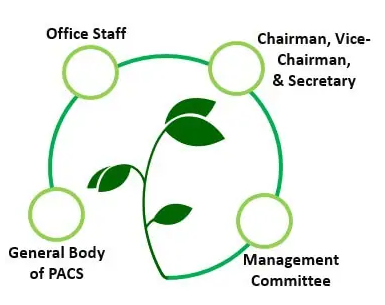
- Office Staff: Responsible for performing day-to-day work.
Functions of PACS
- To provide short and medium-term purpose loans to its members.
- Borrowing an adequate amount of funds from central financial agencies.
- Maintaining the supply of the hire light machinery for the agricultural purpose.
- Promotes savings habits among its members.
- To make the arrangement of supplying of agricultural inputs. Example -seeds, fertilizers, insecticides, kerosene etc.
- It helps its members by providing marketing facilities that could enhance the sale of their agricultural products in the market at the proper prices.
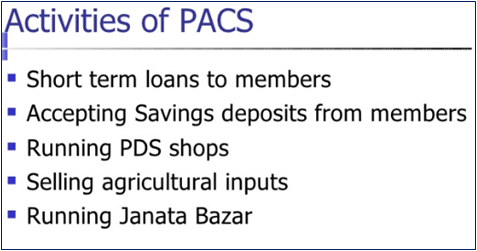
Funds of Primary Agriculture Credit Societies (PACS):
A Primary Agriculture Credit Societies (PACS) can raise funds for carrying out its activities by following means:
- By way of share capital to be raised from members and indirect govt.
- Share capital contribution through the apex co-operative bank and the district central co-operative bank.
- Deposits from members
- Loans
- Donations
- Entrance fee
Significance
- Primary agriculture co-operative credit societies as financial institutions that play a very important role at the grass roots level in the development of local areas. They are multifunctional organizations that dispense a host of activities like banking, on out supplies, marketing produce and trading in consumers goods.
- The Primary Agricultural Cooperative credit societies (PACS) constitute the lowest tier of the three-tier Short-term cooperative credit (STCC) in the country comprising of 13 Cr. farmers as its members, which is crucial for the development of the rural economy. PACS account for 41 % (3.01 Cr. farmers) of the KCC loans given by all entities in the Country and 95 % of these KCC loans (2.95 Cr. farmers) through PACS are to the Small and Marginal farmers.
The major deficiencies of the PACS and their credit are discussed briefly below:
Organizational Weakness
At the primary level, the cooperative credit structure has twofold weaknesses:
(a) Inadequate coverage and
(b) Weak units
Though geographically, active PACS cover about 90% of 5.8 villages, there are parts of the country, especially in the north-east, where this coverage is very low. Further, the rural population covered as members is only 50% of all the rural households.
This inadequacy of coverage itself is attributable to the financial and organizational weakness of individual PACS. In a sense, they are caught in a vicious circle: they are weak because of inadequate membership and they do not attract enough membership because they are weak. This vicious circle must be broken through policy measures of reorganization of PACS.
Why is the borrowing membership low in the PACS?
In the judgement of the Banking Commission, which still holds good, in most cases, one or more of the following reasons are responsible for the low borrowing membership:
(i) Defaults of members in loan repayment and inability of societies to raise resources,
(ii) Inability of the members to provide the prescribed security
(iii) Lack of up-to-date land records or inalienable rights to land or inability to produce sureties,
(iv) Ineligibility of certain purposes for loans
(v) Inadequacy of credit limits prescribed, and
(vi) Onerous conditions prescribed such as share capital contribution at 10 or 20 per cent of loans outstanding and compulsory thrift deposits.
Inadequate Resources
The resources of the PACS are much too inadequate in relation to the short-and medium-term credit needs of e rural economy. The bulk of even these inadequate funds come from higher financing agencies and not through owned funds of ‘societies or deposit mobilization by them. The resource-mobilization ‘Capacity of the PACS will improve substantially, if through reorganization and related measures, they are converted into strong and viable units. Then, they should be able to attract both more deposits and more loans from higher financing agencies.
Over-dues
Large over-dues have become a big problem for the PACS. They check the circulation of loanable funds, reduce the borrowing as well as lending power of societies, and give them the bad image of the societies of defaulting debtors are willful. Bigger landowners take undue advantage of their relatively stronger position in villages in both appropriating cheaper cooperative credit and not paying back their loans in time.
According to the Banking Commission, in most states, over-dues are due to:
(a) Indifferent management or mismanagement of societies;
(b) Unsound lending policies leading to over financing, or financing unrelated to actual needs, diversion of loans for other purposes;
(c) Vested interests and group politics in societies and willful defaults;
(d) Lack of adequate supervision over the use of loans by the borrowers and poor recovery effort;
(e) Lack of adequate control of banks (CCBs) over the primary societies;
(f) Lack of appropriate link between credit and marketing institutions;
(g) Failure to take prompt action against willful defaulters; and
(h) Uncertain agricultural prices.

Inadequate and Restricted Credit
Co-operative credit is inadequate in several senses.
First, the PACS provide credit to only a small proportion of the total rural population.
Second, the societies do not provide full credit even for all productive agricultural activities.
The credit given is confined mainly to crop finance (seasonal agricultural operations) and medium-term loans for identifiable purposes such as the digging of wells, installation of pump sets, etc.
Most of the societies do not provide credit for other productive activities undertaken by the agriculturists. Even for approved productive activities, the credit given is usually not adequate to meet in full the need for credit. In most cases, non-agricultural credit needs even for productive purposes are not met at all Consumption loans are generally not given.
Other Linked Inputs, Extension Service, and Marketing
The provision of adequate and timely credit is only one of the necessary conditions for improving the productivity of farmers and others in villages. Additional facilities in the form of the supply of inputs (like better seeds, fertilizers, pesticides, etc.) extension and marketing service must also be provided to small and marginal farmers to enable them to make good use of the credit given to them.
Already a step in this direction has been taken in the form of Farmers Service Societies (FSS) for small and marginal farmers. But what is required is not the proliferation of new forms of societies, as of revitalizing weaker societies into stronger units, most possibly by reorganizing them into larger-sized multi-purpose co-operatives.
In a nutshell, the Health of PACS
- 93367 PACS - 45241 Profit, 36695 in loss, 4116 – Dormant/ inactive
- Borrower to member ratio less than 50%.
- Of the total assets of Coop. Credit structure – 22% are with PACS
- Among three ST coop. credit structures- PACS are most dependent on borrowed funds
- Since 2010, share of non- agriculture loan through PACS has
- Increased at the cost of agricultural loans’
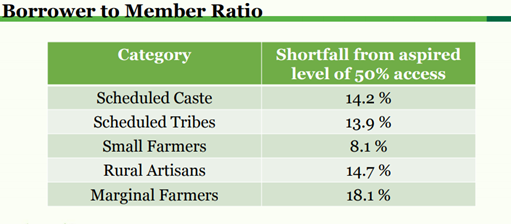
PACS have the network. PACS generally meet out only the short term credit requirements of its members
On the other hand,
- Due to uneconomic land holdings, majority of farmers unable to afford purchase of farm equipment
- New inventions and developments need to be brought to the farms ASAP
- Farmers resort to distress sale as they are in the need of immediate credit
- Adequate storage capacity is not available in the rural areas
- Presently, large number of PACS are rather small in size, to be viable.
- Problems of infrastructural weaknesses, operational inefficiencies etc.
- Therefore, need to re-orient PACS which will make them sustainable and inspire confidence in their existing and potential members.
Recent call on computerization of all PACs:
- Cabinet has approved the computerization of all the PACS throughout the Country and bring them on a common platform at National level and have a Common Accounting System (CAS)for their day-to-day business.
- The aim is increasing efficiency of PACS, bringing transparency and accountabilityin their operations; facilitating PACS to diversify their business and undertake multiple activities/ services.
Importance of Computerization
- Computerization of PACS, will serve the purpose of financial inclusion.
- It will lead to strengthening service delivery to farmers especially Small & Marginal Farmers (SMFs) will also will become nodal service delivery point for various services and provision of inputs like fertilizers, seeds etc.
- The project will help in improving the outreach of the PACS as outlets for banking activities as well as non-Banking activitiesapart from improving digitalization in rural areas.
- The DCCBs can then enroll themselves as one of the important options for taking up various government schemes(where credit and subsidy is involved) which can be implemented through PACS.
- It will ensure speedy disposal of loans, lower transition cost, faster audit and reduction in imbalances in payments and accountingwith State. Cooperative Banks and District Central Cooperative Banks.
The computerization of PACS has already been taken up by a few states, including Maharashtra.
Way Ahead:
- PACS need to be developed as a One Stop Shopfor meeting all the needs of its member
- PACS have to look for new Business opportunities
- Provide much-needed forward and backward linkages.
- PACS can help transform agriculture into a more financially viable activity
- PACS as Multi Service Centers can help members to become self-reliant and promote rural entrepreneurship- facilitating increased income.
- PACS as Multi Service Centers – can financially strengthen the members, by increasing their income through economic linkages with various sectors of rural economy -Doubling of income (The recent decision by NABARD to develop 35,000 PACS into MSCs in mission-mode is a step in this direction.)
- PACS as MSC - Technology supported activities like Micro-ATMs and Wi-Fi Internet.
- Through Micro-ATMs, PACS members who stay far away from the PACS also can have access to banking services.
- PACS as BCs can undertake various activities under financial inclusion and Aadhaar linkage of bank account.
- Potential for expansion of business through convergence with other stakeholders like Farmers Producer Organizations
- PACS can be provided direct exposure to best practicesin various facets of agri-business through partnerships with leading Agricultural Universities / Institutes.
- The PACS are passing through a long phase of re-organization” which was formally started in early 1960’s, following the recommendation of the Committee on Co-operative Credit (1960). But progress to date has been very slow.
Currently, the reorganization work is running along the following lines:
(a) The PACS are being reorganized so that every reorganized PACS covers a gross cropped area of 2000 hectares within a radius of 10 kms;
(b) Non-viable units are either amalgamated with reorganized societies or liquidated. But Compulsory amalgamation/liquidation is not easy, as it often meets with stiff resistance from local beneficiaries and functionaries and the state governments have hesitated using compulsion in the matter; and
(c) The setting up of new types of societies called Farmers Service Societies (FSS) and Large-Sized Multi-Purpose Societies (LAMPS) for tribal and hill areas.
Conclusion
- PACS helps in fulfilling the financial requirements of its members, so their work should not be stopped due to the unavailability of the finances. It makes the loan requirements of farmers and thus helping them in growing their business. The resource-mobilization ‘Capacity of the PACS will improve substantially if, through reorganization and related measures, they are converted into strong and viable units. Then, they should be able to attract both more deposits and more loans from higher financing agencies.
- What is required is to improve the effective coverage of societies by providing credit to increasing proportion of rural households, especially of weaker sections, to widen the range of eligible purposes for which credit is given, and then to meet an approved borrower’s entire credit needs. To realize this objective in practice, the societies must be made organizationally as well as financially strongalong the lines already suggested above.
|
Some of the Innovative things done by a few PACS in Gujarat
RO Water plant;
Construction of Godowns and Accreditation of the same under WDRA;
Custom Hiring Centre for Tractors & Implements;
Consumer Store;
Sale of Cement and Cattle Feed;
Installation of Xerox Machine;
Setting up of Flour Mill;
Planning to go for Renewable Energy
This has resulted in increased membership, more business, more income– a step towards sustainability.
An indicative list of possible business activities
Agro-Storage Centre - Good quality storage capacity as per WDRA Act
Agro-Service Centre - Custom hiring of agricultural implements, collective purchase of inputs
Agro-Processing Centre: Primary and Secondary processing
Agri-information Centre: Extension Services
Agri Transportation & Marketing Facilities
Consumer Store/ Other Miscellaneous Activities
PACS as PO for on-lending to Members for Farm/ NFS/ Service Activities besides ST-SAO
|
“There should be one cooperative for every village and every village should be covered by a cooperative” –
-The Maclagan Committee, 1915
“If cooperation fails, there will fail the best hope of rural India” –
-Royal Commission
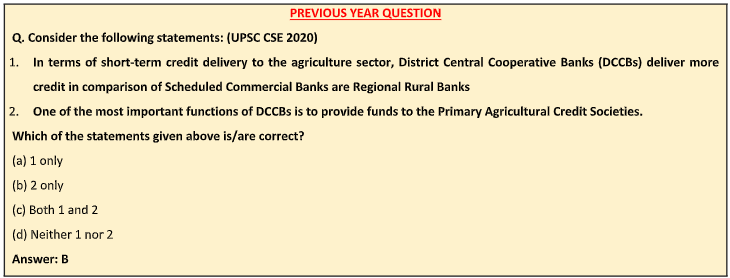

https://indianexpress.com/article/explained/what-are-primary-agricultural-credit-societies-8430329/





















